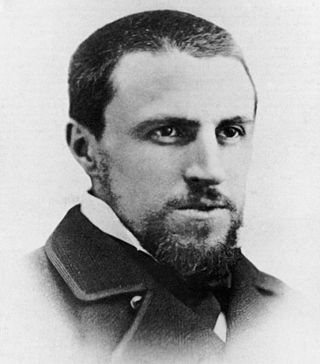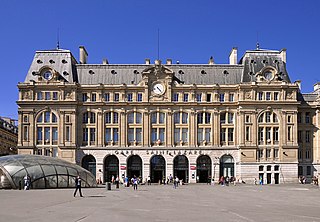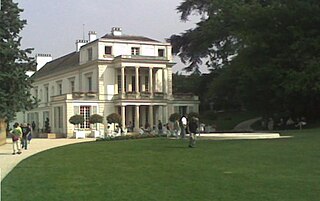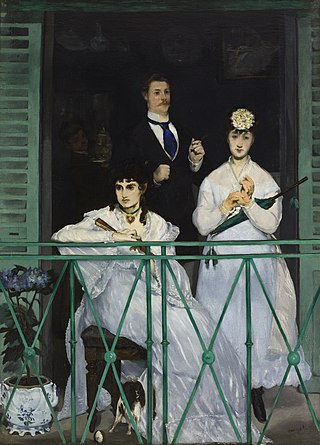
Gustave Caillebotte was a French painter who was a member and patron of the Impressionists, although he painted in a more realistic manner than many others in the group. Caillebotte was known for his early interest in photography as an art form.

Argenteuil is a commune in the northwestern suburbs of Paris, France. It is located 12.3 km (7.6 mi) from the center of Paris. Argenteuil is a sub-prefecture of the Val-d'Oise department, the seat of the arrondissement of Argenteuil. Argenteuil is part of the Métropole du Grand Paris.

The Gare Saint-Lazare, officially Paris Saint Lazare, is one of the seven large mainline railway station terminals in Paris, France. It was the first train station built in Paris, opening in 1837. It mostly serves train services to western suburbs, as well as intercity services toward Normandy using the Paris–Le Havre railway. Saint-Lazare is the third busiest station in France, after the Gare du Nord and Gare de Lyon. It handles 290,000 passengers each day. The current station building opened in 1889 and was designed by architect Juste Lisch; the maître d'œuvre was Eugène Flachat.
Events from the year 1877 in art.
Events from the year 1875 in art.
Trouville-sur-Mer, commonly referred to as Trouville, is a city of 4,603 inhabitants in the Calvados department in the Normandy region in northwestern France.

Yerres is a commune in the Essonne department, in the southeastern suburbs of Paris, France. It is located 18.3 km (11.4 mi) from the center of Paris.

Les Choristes is an 1877 pastel on monotype by French artist Edgar Degas. Part of a series of similar works depicting daily public entertainment at the time, it shows a group of singers performing a scene from the opera Don Giovanni, the only work by Degas depicting an operatic performance without dancers.

Paris Street; Rainy Day is a large 1877 oil painting by the French artist Gustave Caillebotte (1848–1894), and is his best known work. It shows a number of individuals walking through the Place de Dublin, then known as the Carrefour de Moscou, at an intersection to the east of the Gare Saint-Lazare in north Paris. Although Caillebotte was a friend and patron of many of the impressionist painters, and this work is part of that school, it differs in its realism and reliance on line rather than broad brush strokes.
The year 1848 in France, like other European countries, is mostly remembered as the year of a revolution that deposed king Louis Philippe and brought Napoleon III to power as president of the second republic.

The Boulevard Marguerite-de-Rochechouart is a street in Paris, France, situated at the foot of Montmartre and to its south. Like the neighbouring street, it is named after Marguerite de Rochechouart de Montpipeau (1665–1727), abbess of Montmartre. It is a result of the 1864 merging of the boulevards and chemins de ronde which followed the interior and exterior of the Wall of the Farmers-General. It has also been known as the Boulevard des Poissonniers, Chemin de ronde de Poissonnière and Chemin de ronde de Rochechouart. It is served by the Paris Metro stations Pigalle, Anvers and Barbès – Rochechouart.

The Balcony is an 1868–69 oil painting by the French painter Édouard Manet. It depicts four figures on a balcony, one of whom is sitting: the painter Berthe Morisot, who married Manet's brother Eugène in 1874. In the centre is the painter Jean Baptiste Antoine Guillemet. On the right is Fanny Claus, a violinist. The fourth figure, partially obscured in the interior's background, is possibly Léon Leenhoff, Manet's son.

Vue de toits (Effet de neige) (English title: View of rooftops (Effect of snow)) is an oil painting by French impressionist Gustave Caillebotte executed in the winter of 1878 and 1879. The canvas measures 81 by 65 centimetres (32 in × 26 in). It was originally gifted by Caillebotte's brother in 1894 to the Musée du Luxembourg, then transferred to the Musée du Louvre in 1929. In 1947, it was moved to the Galerie nationale du Jeu de Paume, which held many impressionist works in France after World War II. In 1986, it was transferred again to the Musée d'Orsay in Paris, where it is currently displayed. The painting is one of the few Caillebotte works that have remained in public view since the artist's death in 1894.

Les raboteurs de parquet is an oil painting by French Impressionist Gustave Caillebotte. The canvas measures 102 by 146.5 centimetres. It was originally given by Caillebotte's family in 1894 to the Musée du Luxembourg, then transferred to the Musée du Louvre in 1929. In 1947, it was moved to the Galerie nationale du Jeu de Paume, and in 1986, it was transferred again to the Musée d'Orsay in Paris, where it is currently displayed.

Les Orangers is an oil painting by French impressionist Gustave Caillebotte. The canvas measures 155 by 117 centimetres. It was acquired by Audrey Jones Beck and was part of a collection that was on a long-term loan to the Museum of Fine Arts, Houston, before the collection was donated to the museum in 1999. The painting now hangs in the museum building named for Beck.

Le Pont de l'Europe is an oil painting by French impressionist Gustave Caillebotte completed in 1876. It is held by the Musée du Petit Palais in Geneva, Switzerland. The finished canvas measures 125 by 181 centimetres.

Young Man at His Window is a painting of 1876 by the French Impressionist Gustave Caillebotte (1848–1894). The oil on canvas painting measures 117 by 82 centimetres. It is in the collection of the J. Paul Getty Museum in Los Angeles.

A Balcony in Paris is an oil-on-canvas painting by the French Impressionist painter Gustave Caillebotte. It was completed c. 1880–1881. The dimensions of the painting are 55.2 by 39 centimeters. It is housed in a private collection.

Homme au bain is an 1884 oil painting by French Impressionist Gustave Caillebotte.

Argenteuil is an 1874 oil on canvas painting by Édouard Manet (1832-1883), first exhibited at the Paris Salon of 1875. It is one of Manet's first works to qualify fully as an Impressionist work, due to its naturalistic subject and its bold palette, such as the blue of the river, mocked by the Figaro journalist Jean Rousseau as "in the foreground, Argenteuil jam on an indigo river" It is now in the Musée des beaux-arts in Tournai, Belgium.


















